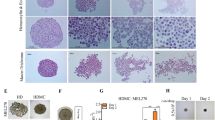Summary
Malignant melanoma poses a serious health risk which is becoming more crucial as the incidence of this disease steadily increases. The development of appropriate in vitro models that reflect the in vivo tumor environment is a key factor for the study of this malignancy. The local tumor microenvironment plays a critical role in the ability of tumor cells to proliferate and metastasize. While interactions among various cell types are known to be important for tumor growth, most in vitro models utilize only tumor cells, ignoring the importance of tumor-stroma interactions, as well as the contribution of immune cells, which may be important for potential therapies. In addition, the cellular architecture found in vivo, known to be involved in changes in gene expression, is not reflected in standard two-dimensional culture systems. In this study, we have utilized rotating-vessel bioreactors to culture minced human melanoma specimens, allowing the culture of three-dimensional structures which reflect the cellular architecture and heterogeneous composition of the tumor site in vivo. The viability of the pieces in culture can be maintained for 1–2 wk. Immunohistochemical analysis shows multiple cellular types similar to the in vivo situation. Therefore, this system provides a unique model of human melanoma that mimics the in vivo tumor environment much more closely than current culture methods. This novel system may be utilized to determine the mechanism of action of current therapy protocols, as well as to develop new treatment regimens.
Similar content being viewed by others
References
Akins, R. E.; Schroedl, N. A.; Gonda, S. R., et al. Neonatal rat heart cells cultured in simulated microgravity. In Vitro Cell. Dev. Biol. 33A(5):337–343; 1997.
Atkins, M. B. The treatment of metastatic melanoma with chemotherapy and biologics. Curr. Opin. Oncol. 9(2):205–213; 1997.
Baguley, B. C.; Marshall, E. S.; Finlay, G. J. Short-term cultures of clinical tumor material: potential contributions to oncology research. Oncol. Res. 11(3):115–124; 1999.
Barth, A.; Wanek, L. A.; Morton, D. L. Prognostic factors in 1521 melanoma patients with distant metastases. J. Am. Coll. Surgeons 181(3):193–201; 1995.
Becker, J. L.; Prewett, T. L.; Spaulding, G. F., et al. Three-dimensional growth and differentiation of ovarian tumor cell line in high aspect rotating-wall vessel: morphologic and embryologic considerations. J. Cell. Biochem. 51(3):283–289; 1993.
Bissell, M. J.; Weaver, V. M.; Lelievre, S. A., et al. Tissue structure, nuclear organization, and gene expression in normal and malignant breast. Cancer Res. 59(Suppl.):1757s-1764s; 1999.
Chopra, V.; Dinh, T. V.; Hannigan, E. V. Three-dimensional endothelial-tumor epithelial cell interactions in human cervical cancers. In Vitro Cell. Dev. Biol. 33A(6):432–442; 1997.
Folkman, J. Endothelial cell and angiogenic growth factors in cancer growth and metastasis. Introduction. Cancer Metastasis Rev. 9:171–174; 1990.
Goodwin, T. J.; Jessup, J. M.; Wolf, D. A. Morphologic differentiation of colon carcinoma lines HT-29 and HT-29KM in rotating-wall vessels. In Vitro Cell. Dev. Biol. 28A(1):47–60; 1992.
Goodwin, T. J.; Prewett, T. L.; Spaulding, G. F., et al. Three-dimensional culture of a mixed mullerian tumor of the ovary: expression of in vivo characteristics. In Vitro Cell. Dev. Biol. 33A(5):366–374; 1997.
Goodwin, T. J.; Prewett, T. L.; Wolf, D. A., et al. Reduced shear stress: a major component in the ability of mammalian tissues to form three-dimensional assemblies in simulated microgravity. J. Cell. Biochem. 51(3):301–311; 1993a.
Goodwin, T. J.; Schroeder, W. F.; Wolf, D. A., et al. Rotating-wall vessel coculture of small intestine as a prelude to tissue modeling: aspects of simulated microgravity. Proc. Soc. Exp. Biol. Med. 202(2):181–192; 1993b.
Graham, C. H.; Kabayashi, H.; Stankiewicz, K. S., et al. Rapid acquisition of multicellular drug resistance after a single exposure of mammary tumor cells to antitumor alkylating agents. J. Natl. Cancer Inst. 86:975–982; 1994.
Ingram, M.; Techy, G. B.; Saroufeem, R., et al. Three-dimensional growth patterns of various human tumor cell lines in simulated microgravity of a NASA bioreactor. In Vitro Cell. Dev. Biol. 33A:459–466; 1997.
Jessup, J. M.; Brown, D.; Fitzgerald, W., et al. Induction of carcinoembryonic antigen expression in a three-dimensional culture system. In vitro Cell. Dev. Biol. 33A:352–357; 1997.
Jessup, J. M.; Goodwin, T. J.; Spaulding, G. Prospects for use of microgravity-based bioreactors to study three-dimensional host-tumor interactions in human neoplasia. J. Cell. Biochem. 51(3):290–300; 1993.
Marshall, E. S.; Finlay, G. J.; Matthews, J. H. L. et al. Microculture-based chemosensitivity testing: a feasibility study comparing freshly explanted human melanoma cells with human melanoma cell lines. J. Natl. Cancer Inst. 84:340–345; 1992.
Meier, F.; Nesbit, M.; Hsu, M.-Y., et al. Human melanoma progression in skin reconstructs: biological significance of bFGF. Am. J. Pathol. 156(1):193–200; 2000.
Moretti, S.; Pinzi, C.; Spallanzani, A., et al. Immunohistochemical evidence of cytokine networks during progression of human melanocytic lesions. Int. J. Cancer 84:160–168; 1999.
Pinelli, D. M.; Drake, J.; Williams, M. C., et al. Hormonal modulation of Ishikawa cells during three-dimensional growth in vitro. J. Soc. Gynecol. Invest. 5(4):217–223; 1998.
Prewett, T. L.; Goodwin, T. J.; Spaulding, G. F. Three-dimensional modeling of T-24 human bladder carcinoma cell line: a new simulated microgravity culture vessel. J. Tissue Cult. Methods 15:29–36; 1993.
Steeg, P. S.; Alley, M. C.; Grever, M. R. An added dimension: will three-dimensional cultures improve our understanding of drug resistance? J. Natl. Cancer Inst. 86:95–97; 1994.
Vescio, R. A.; Connors, K. M.; Kubota, T., et al. Correlation of histology and drug response of human tumors grown in native-state three-dimensional histoculture and nude mice. Proc. Natl. Acad. Sci. USA 88(12):5163–5166; 1991.
Waldman, T.; Zhang, Y.; Dillehay, J. Y., et al. Cell-cycle arrest versus cell death in cancer therapy. Nat. Med. 3(9):1034–1036; 1997.
Zhau, H. E.; Goodwin, T. J.; Chang, S. M., et al. Establishment of a three-dimensional human prostate organoid coculture under microgravity-simulated conditions: evaluation of androgen-induced growth and PSA expression. In Vitro Cell. Dev. Biol. 33A(5):375–380; 1997.
Author information
Authors and Affiliations
Corresponding author
Rights and permissions
About this article
Cite this article
Licato, L.L., Prieto, V.G. & Grimm, E.A. A novel preclinical model of human malignant melanoma utilizing bioreactor rotating-wall vessels. In Vitro Cell.Dev.Biol.-Animal 37, 121–126 (2001). https://doi.org/10.1290/1071-2690(2001)037<0121:ANPMOH>2.0.CO;2
Issue Date:
DOI: https://doi.org/10.1290/1071-2690(2001)037<0121:ANPMOH>2.0.CO;2




